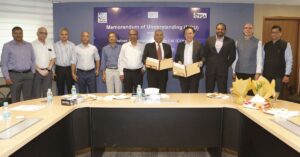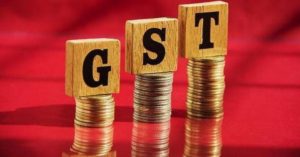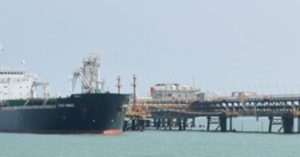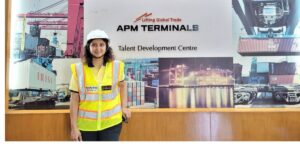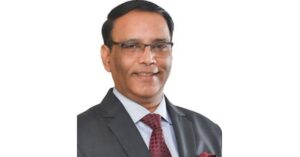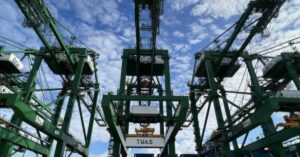When I was reading your introduction, the whole paragraph was filled with a lot of diversity issues. So, let us begin talking about diversity. You have been a champion for bringing gender diversity in shipping industry. Can you give me an insight into what is the status of women in our industry and what are the typical challenges they face when they want to rise to the leadership positions?
Since you were our partner in bringing out the 2018 Sandvik survey which went on to be the report in 2019, I will draw some references from that survey itself wherein we spoke to over 200 employers and over 1000 women in the maritime sector. What we found is today definitely the status is much better than what it was 20 years back. We have more women in the forefront and more visible role models coming forward. But we are still stuck in the same situation where we have the first CMD of SCI, the first maritime pilot in India. So, we are still at a stage where we are stuck on the firsts, and we need to move beyond that and create more women leaders and more women in maritime so that they stop being the only women there and we need to have more such women come up. In that sense we achieved quite a bit, but we need to push this agenda further.
So, where is the challenge? Is it from the working women in the industry? Or is it the mind-set of the corporations or companies?
I think it’s a little bit of both. On one hand there are a lot of women who really want to participate and do well and rise to these leadership positions, but they hold themselves back. Women are less likely to apply for promotions, to put their hand up, speak first at board meetings and industry gatherings. One push has to be done from the women; they need to step forward, go ahead and grab all the opportunities that come forward to them, but at the same time, the companies need to create an ambience that is conducive for women to come forward where they feel more welcome. A very senior woman in maritime said that when she joined the board, they didn’t know what to do with her because she was the only or the first woman on the board. I don’t think that it’s a conscious thing that people try to block women. It’s just that there are women now entering arenas in the boardroom, in positions where they were none, and they are not used to or accustomed to having women onboard. A lot of gender sensitization, awareness is required because when you are hiring, you tend to hire somebody who looks like you. So, if the board is full of gentlemen and it’s much likely they feel that a gentleman would fit in. It’s those mindsets that we need to push and the more women come forward, it would become easier, but I think the initial push has to be done by the industry.
So, you feel that’s the way the changes should come. You have been advocating and trying to sensitize the companies or governments around you. So, what was the response from these interactions and how is currently the policy or legislature framework towards making more women rise into the higher positions?
In the industry most people are either believers or non-believers. So, when they are believers, I find most of them believe in women for women’s sake, they believe it’s the right thing to do, but as a businessperson myself, I know how important it is to look at your bottom lines. There has to be a business case behind it and that’s why we did this research in 2020 to show that there is actually a business case for diversity, and why having a diverse workforce means better results, productivity, innovation team work and profits. I feel there are lot of people who believe in diversity that there should be more women, but they don’t understand the implications behind having more women or they don’t have the right resources for hiring more women, attracting them. So, the intent is there but they don’t know how to proceed and they need a lot of handholding and guiding. Big companies have huge resources at their disposal, they can easily implement these programmes. But what about small and midsize companies? They need a lot of support in this respect.
Coming to the non-believers, I think that is very critical because they really don’t think that women have a place whether it is on board a ship or on shore, and I think it’s just important to convince them with more research or best practices. That is a very big hurdle that needs to be crossed. With regards to legislation, I believe that in India we are providing equal opportunities but there are still certain places like for example, in ports women are not allowed to work after dark and while we are trying to protect the women because it is for their safety, I think it is also creating a hurdle for them, so we need to find a way where we can have more women in operational positions, giving them the opportunity and not having those hurdles wherein they can’t enter the port after dark because it’s not safe for them.
A lot of people don’t want to put women on ships because it’s not safe for them, but it’s their responsibility to make sure the ship is safe to receive women, and I think that is where the challenge lies.
As part of your advocacy drive, you have started this MaritimeShEO. You coined a new word and you are making it a phenomenon. In November last year, you organized a major conference bringing lot of global leaders also who are supporting gender diversity, who are already working in this field. So what was the objective of this conference and what are key takeaways?
Initially the intent was to have the conference physically in March in India with around a group of 150 people and then the pandemic struck. We intended to launch the MaritimeShEO leadership accelerator programme and this was a way to get the industry involved. But with the pandemic coming in we have to go virtual and this presented a huge opportunity. We didn’t envisage that it would grow so big, the objective was to get the industry stakeholders together. The conference had industry stakeholders from all the verticals, from ship owning to freight forwarding, every single aspect was covered. We had close to 1600 people attend from 77 different countries, we had close to 70 speakers from 25 different countries and I think the major objective was to get the industry all together to stop talking in silos and to get everybody on one platform where we can speak and exchange views on what we can do to make the industry a better place.
That was achieved really well and that puts a huge responsibility on us to make sure the takeaways from the conference are translated into action. The first important thing that came out through all the talks is that there is a major need for gender sensitization or awareness in the industry. Now, this is the biggest challenge because you cannot measure how much you have done for gender sensitization, but we can have male allies advocating, more visible female role models and actually put people through these gender sensitization programmes. The second thing is obviously with regards to policy, whether we are talking about the government of India or the IMO when they speak to the member states, what’s really needed is to push it from top down to make sure that companies are inclined to hire more women. By that I don’t mean we need to have quotas. I am very much against quotas but at the same time, I think there needs to be some sort of policies there to protect women. Especially, I think procedures to protect the interests of female seafarers. We need to have procedures to safeguard the interests of women.
Finally, the best practices that were shared were most inspiring, and the people who are doing this, the companies that are sharing the best practices with us, these stories need to be told to inspire other companies. The whole objective of getting the best practices panel and awarding these companies was to get other companies to sit up and be inspired.
I am sure during the deliberations, lot of ideas, action plans must have come. One of the things I understand is that IMO wanted to get associated with the accelerator programme? Can you tell us a bit about it?
The women leadership accelerator programme that we had originally designed as a physical programme and wherein we were going to get support from various corporates, they had pledged their support, went on a backburner because of the pandemic and corporates were not able to fund it. But when the conference came on, the IMO questioned us about the accelerator programme and we said we are stuck up and in an amazing development, they actually announced that because the women’s day theme for 2021 by the UN is for women in leadership positions, to support that objective, they would be sponsoring or funding women from developing countries to go through our accelerator programme and we would be launching it in March. It’s a great development and by going virtual, we have so many more opportunities to reach so many more women and while the IMO is intending to have all these women fly down to India to do the leadership accelerator in March, I think that other companies should also come forward to say okay, when you are starting the programme, we would also like to support it.
That’s a huge opportunity and as a matter of pride for me because as an Indian and first and foremost we are going to get that opportunity to train these women from across the various developing countries across continents to undergo this rigorous leadership accelerator and that is the term that we had coined MaritimeShEO, creating the next generation of women leaders. That is our ultimate goal and the leadership accelerator would be working towards that goal.
How does this programme work? How many women can be trained and how to take part in this programme?
The IMO is going to actually set out the application process. They haven’t decided on the total number of women but we are looking at around 15 women. They would be handpicking these women who are working mainly with the regulatory bodies or with the governments because the member states of IMO want to support them. Primarily the women would be invited to apply from the member states who are working in the regulatory bodies, with the government. Beyond that we will have to wait till January because we are still waiting for the IMO to give us a green signal to go ahead and announce all the details.
Wonderful. So other than the accelerator programme, what is on your agenda for 2021 and beyond?
There is a lot to be done. The accelerator programme was the main basis of what we started, but we realized that we can’t stop there. So, I have been approached by a lot of corporates, associations where they want to develop manuals or handbooks on how to sensitize their people on ships and on shore. The next major step is to ensure that we have these resources available to the industry, so that when they are recruiting, at the time of interviewing, say for example they have an all-male panel of people interviewing, they should be able to rely on certain resources that we provide them, right from the recruitment to the induction to the promotion to make sure we are able to give industry that sort of support system. Secondly, we think that we need to have more material available so we are working on doing a video where we actually have a lot of sensitization. That video would be available across the globe on various ships and that would help people understand that when there is a woman onboard, what are things to be done and not to be done? That’s the second aspect with the gender sensitization.
The third aspect is we are thinking of coming up with a best practices guide for the industry. We highlighted 4 or 5 stories at the conference but there are so many more stories to be told, and lastly, I think there are so many women in maritime. We need to focus on all of them and get them visibility. So, we are working on empowering women through various aspects, one of them is mentoring, to mentor these women, to conduct more research because the more research we have, the more data we have, that’s when people actually sit back and say, okay we need take this seriously. So, that’s a few things we have planned for the coming year.
Clearly, Miss. Sanjam in the last 7 to 8 years that we have known you, you have brought the gender diversity issue onto the centre stage either through WISTA India or subsequently through MaritimeShEO. Now people are more aware of these issues and at least they are talking about it, they are willing to sit with you and then discuss these issues. It’s a wonderful job that you have done and we wish you continue to do that. Thank you so much for joining with us today and sharing lot of insights into gender diversity issues.
Thank you so much and may I also take this opportunity to thank you Mr. Ram Prasad. You have known me since when I was wet behind the ears and very very new to the industry and it is kudos to a gentleman like you who have actually selflessly supported me in my quest without really wanting anything in return and it is really heartening to see gentleman like you who step up to support the women and I would like to give one example if you allow me, at most of the industry dinners and gatherings where the WISTA women gather, they are usually given a table or put somewhere in a corner, but there is an incident I would like to share where you had your 10th anniversary celebration of the Containers India and the dinner was being set up, somebody asked you where should WISTA women seat themselves and you said anywhere. You did not put us in a corner or did not want to side line us and I think we need more gentlemen like you. You are already an ambassador for us, so thank you for what you do to support us and I am sure together we are stronger and together we can really create a better maritime industry for all of us.
Thank you so much for those kind words and I am also happy to be associated in all your initiatives and Maritime Gateway and myself personally will be associated with these activities and let us support wherever we can. Thank you very much and we wish you all the best.



